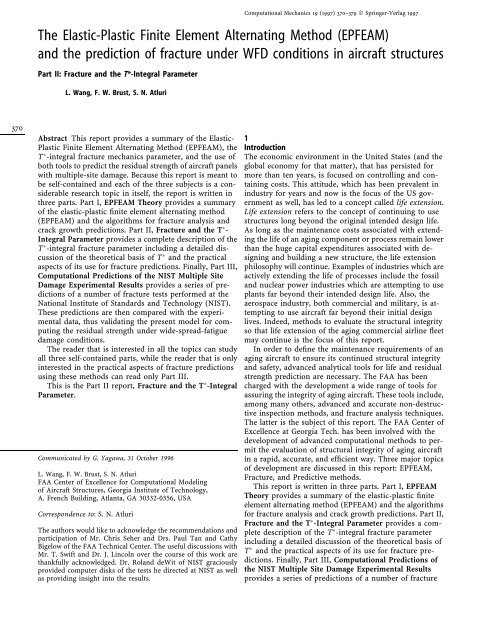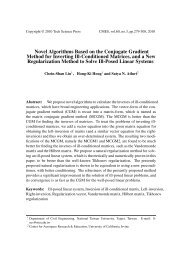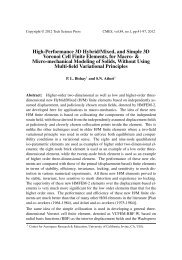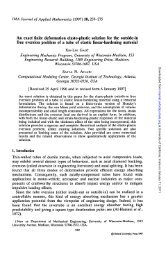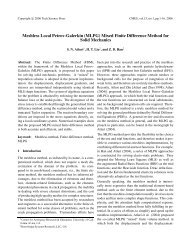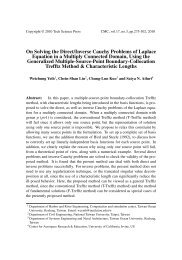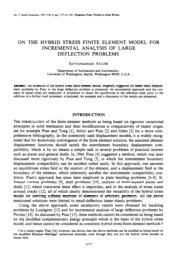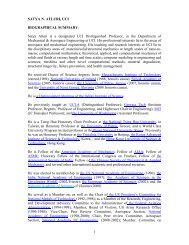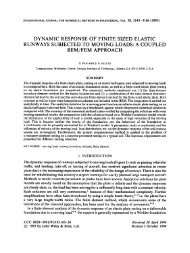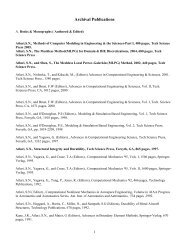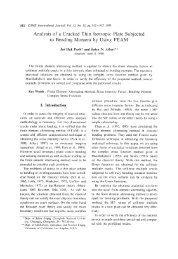The Elastic-Plastic Finite Element Alternating Method ... - Springer
The Elastic-Plastic Finite Element Alternating Method ... - Springer
The Elastic-Plastic Finite Element Alternating Method ... - Springer
You also want an ePaper? Increase the reach of your titles
YUMPU automatically turns print PDFs into web optimized ePapers that Google loves.
4Practical numerical evaluation of the T -integralFigure 2 is a blowup of a ®nite element mesh where a crackis propagating. <strong>The</strong> crack growth direction is a symmetryplane, hence only half the mesh is present for this twodimensional problem. In Fig. 2a, a rectangular path, C e ,isde®ned, which is of size 3h parallel to, and perpendicularto, the current crack location. Note that in practice thepath de®nitions are usually square rather than circular.After loading and permitting elastic-plastic and/or creepstraining, but before crack growth, we may calculate theT -integral as the line integral:ZT ˆ ‰Wn 1 t i u i;1 ŠdC: …8†C eˆ3hAfter the crack grows (Fig. 2b), one may also evaluate T along the stretched ``Dugdale'' path, ~C eˆ3h , where e ˆ 3hfor a growing crack is understood as the distance in frontof and perpendicular to the current crack tip, also usingEq. 8. Note that if we evaluate the integral along the dashpath (C e , Fig. 2b, which is analogous to the moving path ofFigs. 1a and 2a), we obtain signi®cant errors in the calculatedvalues of all the integrals. <strong>The</strong> source of thesenumerical errors is discussed in the next paragraph.<strong>The</strong>re is an important practical reason for requiring T to be evaluated on a Dugdale-type path such as in Figs. 1bor 2b. Consider crack growth to be modeled by a noderelease technique in a ®nite element model (Fig. 2). If weconsider a dashed path in Fig. 2b (i.e., the square path thatmoves with the crack tip with the center at the currentcrack tip) through the ®nite element mesh at the currentcrack tip, a 0 ‡ Da ˆ a, then two elements model thecomplete angular variation of the crack tip ®elds from 0 top at the crack tip, with the coordinate system as in Fig. 1aor 1b. It is clear that this mesh discretization is grosslyinadequate and that the calculated stresses, strains, etc., inthe growing wake region are incorrect. If one attempts toevaluate T along a square path which passes throughthese crack wake elements, large errors are introduced intoFig. 2a,b. Integral de®nitions of paths: a Initial Crack b Aftercrack growthT (i.e., in effect, T cannot be calculated accurately).Moreover, if one uses a moving crack tip mesh to modelcrack growth, the errors associated with mesh shifting andremeshing lead to similar errors if C e is circular or square(see Brust, Nishioka, Nakagaki and Atluri (1985)). Kostylevand Margolin (1993) in their studies of the use of T tocharacterize elastic-plastic crack growth found no need forthe use of a `Dugdale' type path. <strong>The</strong>y found that using themoving square path of Fig. 2 gave good results. Our experiencedoes not indicate that this is possible unless theinelastic zone at the growing crack tip is very small. Itshould be noted that the above comments are equallyapplicable with the EPFEAM method.In actual numerical calculations, it is more convenientto evaluate the integrals as follows. We may write (usingthe divergence theorem and equilibrium considerations):T j e ˆ 0 ˆ lim ‰Wn 1 t i u i;1 ŠdC …9†C eˆ0ZZT j eˆ0 ˆ ‰Wn 1 t i u i;1 ŠdC ‡ ‰W ;1 …r ij e ij;1 †ŠdVC f V fe!0Z…10†where C f is a path which encircles the crack far from thecrack tip, and V f is the volume within C f . <strong>The</strong> numericalvalue for Eq. 9 may be zero for elastic-perfectly-plastic rateindependent materials, but is non-zero for elastic, hardeningplastic, and high strain rate viscoplastic materials.Note that T j eˆ0 of Eq. 10 is path independent for any C f .This path independence is irrelevant, except as a check onmesh size re®nement. We have found that lack of pathindependence when T j eˆ0 is evaluated along many paths,C f and using Eq. 10 are a clear indication to improve themesh re®nement and reanalyze the problem.<strong>The</strong>n, to evaluate the integral for a given e :ZT j eˆ3h ˆ ‰W n1 t i u i;1 ŠdCC fZ…11†‰W ;1 …r ij e ij;1 †ŠdV:V f V eˆ3hThus, it is convenient to evaluate all of the integrals usingEq. 11 (or a similar form for other integrals) and thensubtract out the V e term for each path size, e, of interest.Since it is simple to store the V e value in each element, oneonly needs to know the current crack tip location, and thee values to evaluate the integrals. In practice, we havefound that a buffer zone of at least two elements (for 8-node isoparametric elements) is often required. Thismeans that, in Fig. 2, e 2h. Smaller values can result ininaccuracies. However, some recent applications using theelastic plastic ®nite element alternating method have enabledonly one large element to be used along the crackgrowth direction. Also, e should be large enough to bebeyond the process or large strain zone.We generally evaluate the integrals for ®ve or six valuesof e, the minimum e being de®ned as the length of twoelements. Since the numerical value of the integrals dependson e, we thus have ®ve or six different resistancecurves which can be used as the fracture resistance curvefor another history dependent analysis prediction. In373
374principle, each resistance curve should be able to characterizefracture as long as e is not too large. For large e, theenergy lost through ~C e becomes divorced from the cracktip dissipation energy and, thus, will not characterizehistory-dependent fracture. For a stationary crack, theenergetic interpretation of these integrals is not appropriate.<strong>The</strong> philosophy of characterizing an elastic-plastic orcreep crack growth process via the T -integral parametermay be described as follows. A material resistance curve isdeveloped by performing an experiment on a laboratoryfracture specimen. This analysis phase has been termed`generation phase' analysis by Kanninen (1978) and Kanninenand Popelar (1986) since the purpose is to generatethe resistance curve. <strong>The</strong> experiment is then modeled viathe ®nite element method where the T -integral is calculatedalong several small ®nite-sized paths. This numericalexperiment then produces the material resistance curve(s),which depend on the path size de®nitions, e. In principle,any of these path size de®nitions may be used as long as eis not too small so that numerical errors occur or too largeso that the energy dissipated is divorced from crack tipevents. <strong>The</strong> behavior of other arbitrarily loaded andcracked structures can then be predicted by modeling thetime history of loading and using this generated resistancecurve (as de®ned by e) as a crack growth criterion. <strong>The</strong>resistance curve is assumed to be an intrinsic materialproperty. <strong>The</strong> time history of crack initiation and growthmay thus be predicted. <strong>The</strong> analogy to elastic-plasticfracture mechanics based upon the J-integral may bemade.Also, for engineering predictions, the methods may beused as an empirical parameter-rate type of approach byrelating _a or da/dN to the rates or changes in the parameter.This has been done, as will be summarized in thenext section.5Example Applications of the T -integralThis section reviews some of the work performed to datewhich uses T -integral methodology to predict crackgrowth and fracture of cracked specimens and servicestructures. In the following, we are only concerned withstudies which illustrate the use of the method and providevalidation. <strong>The</strong> validation of this method can only beachieved by comparing predictions with experimental results.We ®rst review the literature to summarize the workthat has been performed which validates the T -integralmethodology. Next, several detailed examples, taken fromthis literature, are provided which illustrate the performanceof the method. It should be noted that the Part IIIreport in this series provides a number of new predictionsof residual strength for the multi-site-damage problem.<strong>The</strong> examples shown in the following section considerhistory dependent elastic-plastic fracture, creep fracture,and some earlier predictions of MSD using EPFEAM.<strong>The</strong> ®rst practical validation of the T technique wasshown by Brust, Nishioka, Nakagaki, and Atluri (1985) andBrust, McGowan, and Atluri (1986a). This work consideredelastic-plastic stable crack growth as well as the effect ofunloading on the stable crack growth process and clearlyshowed that T could capture the history dependent crackgrowth processes while the classical parameters (the J-integraland the crack tip opening angle) could not. An exampleof this work will be shown later. Brust and Atluri(1986b) also considered and validated that creep crackgrowth could be modeled using T , although veri®cationwas not provided.It is interesting to point out that, after this originalvalidation work, there was about a ®ve-year lag beforemore studies were made. <strong>The</strong> main reasons for this delayin further veri®cation work were twofold: <strong>The</strong> T -integral methodology received criticism in severalearly papers after the original publications showingits practical utility. As was shown earlier and will beillustrated in some of the examples to be presented later,this criticism was unfounded. However, as is usuallythe case, it takes some time for a new technique in any®eld to receive widespread acceptance. <strong>The</strong> issue of how practical the method is for analyzingservice structures was an important issue early on sincecomputational methods were required. <strong>The</strong> method wasconsidered nice theory, but was not practical sincecomplex and detailed ®nite element analyses were requiredto apply it. However, as will be seen in one of theexamples to be discussed later, the development of theNonlinear <strong>Finite</strong> <strong>Element</strong> <strong>Alternating</strong> <strong>Method</strong>(NLFEAM), which is an advanced and computationallyextremely ef®cient fracture analysis methodology whichhas emerged recently, renders the T methodologypractical for modeling service structures.Since 1992, however, a number of publications whichverify the predictive ability of the T -integral methodologieshave appeared. Kim et al. (1992) showed that DT could characterize the complex creep-fatigue crack growthprocess under the severe service conditions experienced inthe space shuttle main engine environment. Other classicalfracture parameters produced poor results compared withthe extensive experimental data that was compiled in thisprogram. Also Liu, Han, and Yan (1992) showed that T can characterize large scale creep crack growth whileclassical creep parameters again failed to perform. In 1993,Kostylev and Margolin (1993), in the context of elasticplasticcrack growth, illustrated the ability of T to characterizequasi-static and dynamic crack response. From1992 to the present, Brust and co-workers (1994±1995)have shown that the T -integral can characterize the hightemperature history dependent crack growth response ofseveral steel alloys used in fossil fueled energy productionfacilities. An example of this work is presented later. Experimentalmethods to evaluate the T -integral have alsobeen recently developed (see Okada, Suzuki, Ma, Lam,Pyo, and Atluri (1995)). Finally, since 1994 Atluri and coworkers(1994-1995) have veri®ed that T can characterizethe multi-site damage induced by multiple cracks in anaircraft fuselage. This work introduced the <strong>Elastic</strong> <strong>Plastic</strong><strong>Finite</strong> <strong>Element</strong> <strong>Alternating</strong> <strong>Method</strong>ology (EPFEAM) whichis a great advancement to nonlinear computational fracturemechanics analysis procedures since it permits simple,fast, and cheap analyses to be performed using the T theory. An example from this work is illustrated also.
5.1Example 1 ± <strong>Elastic</strong>-plastic stable crack growthThis example is taken from the ®rst veri®cation study(Brust, Nishioka, Nakagaki, and Atluri (1985) and Brust,McGowan, and Atluri (1986)), and illustrates several importantfeatures of T . Consider an A533B steel which ismade into a number of compact tension specimens andtested. <strong>The</strong>se specimens were analyzed using elastic plastic®nite element analysis from the beginning of the test,through crack initiation and growth, through failure. Sincethese were displacement control tests, the analysis inputconsists of the load point displacement versus crackgrowth record and the predictions consist of the loads, theT -integral, and other fracture parameters. Figure 3 illustratesthe behavior of T throughout one of the tests. Thisanalysis was performed using four different mesh re®nementswith near crack tip mesh size (h from Fig. 2; hereh ˆ Da, the crack growth step size) de®nitions. Fig. 3,which is the T resistance curve for this material fore ˆ 0:6 mm (see Fig. 2), shows that T is mesh size independent.Note that the solution using the Da ˆ 0:6 mmmesh re®nement is very coarse, and violates the rule ofthumb discussed in the previous section requiring a bufferzone of two elements for the path de®nition, but still doesFig. 3. T resistance curves for different near-®eld meshre®nementnot deviate much from the converged solutions representedby the Da ˆ 0:1; 0:15 mm solutions in Fig. 3. Alsoobserve from Fig. 3 that T rises up and reaches a saturationvalue at steady state. This is a typical feature of theT resistance curve, and also is observed under creep crackgrowth conditions.Finally, an example illustrating the importance of consideringhistory dependence is presented (Brust,McGowan, and Atluri (1986). An ASTM A508 steel compacttension specimen was loaded beyond crack initiation,then completely unloaded and reloaded. <strong>The</strong> response ofthis specimen was predicted using three different resistancecurves based on J, CTOA, and T . <strong>The</strong> resistancecurves were developed from a generation phase analysis ofanother A508 compact specimen which was not unloaded.<strong>The</strong> J-resistance curve rises continuously, the CTOA resistancecurve starts with a high value and lowers to aconstant value, while the T resistance curve is of the formof Fig. 3, except numerically different since the material isdifferent. <strong>The</strong> unload/reload specimen was analyzed threedifferent times in an application phase prediction to observewhich resistance curve can capture the history dependentdamage caused by the unload/reload cycle. <strong>The</strong>predictions are compared with experimental results in Fig.4. Figure 4 shows that the crack growth reinitiation afterthe unload/reload cycle was accurately predicted using theT methodology since the history of crack growth andunloading is accounted for with T . <strong>The</strong> analyses based onJ or CTOA yielded nonconservative predictions. While thisis a simple example, it was the ®rst which clearly illustratedthe advantages of T compared with the othercurrently accepted fracture parameters. It should bementioned that J and CTOA are still widely used in manyindustries to predict elastic-plastic crack growth. It is timethat T methodology begins to work its way into the applications'arena.5.2Example 2 ± Aircraft fuselage multi-site damage predictions<strong>The</strong> example summarized above represented the ®rst developmentof a practical application procedure and veri-375Fig. 4. Experimental and analytical loadversus crack-growth curves for A508 steel
376®cation of the T -integral methodology. As discussedpreviously, after this work was completed about ten yearsago, there was a lull period of about ®ve years before moreveri®cation work was performed. At present though, alarge amount of work is being performed which is furtherverifying the ability of T to characterize practical fractureproblems where conventional parameters cannot perform.This ongoing work deals with high temperature creepfracture (Brust and co-workers (1994±1995)) and elasticplasticfracture (Atluri and Co-workers (1994±1995)). <strong>The</strong>example discussed in this subsection illustrates one case ofthis veri®cation work for elastic-plastic fracture and residualstrength for a large crack which approaches severalsmaller cracks, while the example in the next subsectionillustrates the performance of T for severe history dependentcreep crack growth. <strong>The</strong> work in this sectionrepresents earlier EPFEAM work using T to predict residualstrength. <strong>The</strong> work presented in the Part III reportuses the new EPFEAM developments to predict residualstrength under MSD conditions. Since this is ongoingwork, we expect a number of additional papers detailingthis in the near future.<strong>The</strong> ®nite element alternating method (FEAM) has seenextensive development and application for both two andthree dimensional single and multiple elastic crack problemsin recent years (see Nishioka and Atluri (1983), Atluri,Harris, Hoggard, Miller, and Sampath (1992) andAtluri, Sampath, and Tong (1991) for some examples). Itcan now be said that FEAM represents the state of the artpractical fracture mechanics analysis methodology sincethe mesh does not have to be modi®ed to directly accountfor the crack. <strong>The</strong> use of the method results in greatlyreduced man hour and computational requirements. <strong>The</strong>method was extended to permit elastic-plastic crackgrowth analyses. <strong>The</strong> original <strong>Elastic</strong> <strong>Plastic</strong> FEAM techniqueis summarized by Pyo, Okada, and Atluri (1994a,1994b), Shenoy, Potyondy, and Atluri (1994), and Singh,Park, and Atluri (1994). <strong>The</strong> new improvements toEPFEAM are discussed in the Part I portion of this reportseries. <strong>The</strong> EPFEAM uses the initial stiffness technique inconjunction with the radial return plasticity algorithm andthe elastic FEAM method to iterate to a solution. <strong>The</strong>method was used to perform the analyses of multisitedamage and to evaluate the effectiveness of the T approach.Multi-site damage is a potential problem in certainmodels of aging commercial and military aircraft. <strong>The</strong>problem consists of a major crack with adjacent smallercracks as illustrated at the top of Figure 5. <strong>The</strong> analysisresults summarized here are for a ¯at panel rather than acurved fuselage. <strong>The</strong> test methodology and results aresummarized in Broek (1993). As illustrated in Fig. 5, six ofthe tests were analyzed; three had single cracks of differentsize (Tests P1 to P3), two (tests P4, P5) had major cracksdifferent size with one adjacent smaller crack at each cracktip (the smaller cracks were of the same size as seen inFig. 5), while test P6 had a major crack with two adjacentequal size cracks at each tip.Only one coarse mesh was developed and used for eachanalysis. This is, of course, one of the major advantages ofthe EPFEAM method. <strong>The</strong> stress-strain relationship wasFig. 5. Crack con®gurations of ¯at panels analyzedmodeled using a Ramberg-Osgood approximation of theproperties of 2024-T3 aluminum alloy. <strong>The</strong> T -Resistancecurve was developed by performing a generation phaseanalysis on specimen P1 which was one of the single crackcases. <strong>The</strong> T -Resistance curve, which is provided by Pyo,Okada, and Atluri (1994), had the characteristic initiationvalue and increase to a saturation value of the type illustratedin Fig. 3. This curve was then used as the resistancecurve for all other ®ve tests in application phase analyses.<strong>The</strong> predicted maximum loads for cases P2 and P3 (seePyo, Okada, and Atluri (1994)) compared very well withthe experimental data. <strong>The</strong> results for cases P4 and P5,which had one MSD crack at each tip, are illustrated inFigs. 6 and 7. It is seen that the predictions compare wellwith the test results for both cases. Again, these predictionsare made using only the T -Resistance curve as thefracture criterion. Finally, the predicted results for the twoMSD cracks adjacent to the main crack (Fig. 8) slightlyover predict the experimental data but are also consideredto be quite good.Again, it is illustrated that T methodology providesgood predictions for the case of MSD cracks. Many othercomparisons of predictions using T theory are made forother multiple crack problems in the cited references andwill appear in pending publications.5.3Example 3 ± History dependent creep crack growthHere we show an example of the behavior of a compacttensionspecimen made of a 9 Cr-1Mo steel which issubjected to a high-temperature (528 °C) load spectrum
Fig. 6. Comparison between the results of tests and EPFEAMfor P4consisting of a load and hold for twenty-four hours, unloadto zero load and hold for ®ve minutes, reload andhold for twenty-four hours, etc. <strong>The</strong> test lasted for aboutthirty days before failure. <strong>The</strong> ®ve-minute hold time wasenough time for signi®cant displacement recovery to occuralong with a signi®cant compressive zone to develop at thecrack tip. <strong>The</strong> alternating tension-compression-tensionconditions experienced near the crack tip are known tocause extensive creep damage near the crack tip (seeKrishnaswamy, Brust, and Ghadiali (1995), Brust andMajumdar (1994), Brust (1995a, 1995b)). Crack growthbegan on about the eighth day. <strong>The</strong> Murakami-Ohnoconstitutive law (see the cited References), which can accountfor the cyclic creep constitutive response, was used.<strong>The</strong> load versus crack growth record was input to the ®niteelement analysis. <strong>The</strong> applied maximum load was 23.353KN and plane stress was assumed.<strong>The</strong> predicted and experimental displacementsthroughout the entire 700 hours considered here areshown in Fig. 9. <strong>The</strong> analysis used the Murakami-Ohnoconstitutive law. Predictions using other constitutive lawstypically used for creep analyses (i.e., the Norton or strainhardeningcreep law) produce results signi®cantly lowerthan these. <strong>The</strong> upper curve represents the experimentaland predicted displacements at the end of the hold period,just before unloading, while the lower data points representthe displacements at the end of the hold period, justbefore unloading, while the lower data points represent the377Fig. 7. Comparison between the results of tests and EPFEAMfor P5Fig. 8. Comparison between the results of tests and EPFEAMfor P6Fig. 9a,b. Comparison of displacements for 9 Cr-Mo test: aMaximum displacements at the end of the reload-hold times.b Minimum displacements at the end of the unload-hold times
378displacements at the end of the unload hold period. <strong>The</strong>comparison is reasonable except beyond about 630 hours,where the predicted results begin to become large. <strong>The</strong>experiment began to experience unstable behavior at timesgreater than 700 hours.<strong>The</strong> dif®culty with using classical creep crack growthpredictive methods for these creep-fatigue problems is thatthese methods cannot account for the alternating tensileand compressive creep damage which develops at themoving crack tip. Even though the specimen is only unloadedto zero load, a large compressive creep zone emanatesfrom the crack tip as illustrated in Fig. 10. Figure 10illustrates the compressive stress zone that develops at theend of the unload hold periods at three different timesduring this test. (<strong>The</strong>se are analysis results). <strong>The</strong> classical(C ; C t ; etc.), which are based on asymptotic solutionsusing simplistic constitutive relations, cannot account forcyclic creep conditions.<strong>The</strong> T -integral was calculated throughout this entiretest. A plot of T versus time is illustrated in Fig. 11. T was evaluated on three different path sizes (R ˆ e here).Recall that unloading occurs at twenty four-hour incrementsthroughout this analysis Each time an unload/reloadoccurred, T remained at its' saturation value untilafter 600 Hours. After 600 Hours, T rises, i.e., failure ispredicted. Note that T achieving a constant valuethroughout the majority of the test shows that it is a validparameter since, during stable crack growth, only a givenFig. 10a-c. Compressive stress zones after unloading and holdingfor 0.1 hoursFig. 11. T -integral versus time for several de®nitions of path sizeamount of energy may be deposited at the growing cracktip. <strong>The</strong> rising T after 600 Hours indicates that the crackwas modeled as growing too slowly (recall that the input isexperimental crack growth versus time). What this meansis that, in an application phase analysis, after 600 Hours,T would predict more rapid crack growth than that observedexperimentally, i.e., T would predict earlier failurethat the experimental times.As indicated in Fig. 11, crack growth begins at 192hours, after the eighth unloading. Also note that the T integral attains a nearly constant value (close to the nucleationvalue) throughout the entire crack growth andtime history (between 100 and 130 KJ/m 2 , as indicated bythe lines in Fig. 11). This suggests that a constant value ofT will characterize crack growth under creep fatigueconditions. After about 628 hours the curves become unstable,suggesting that unstable creep failure is predicted.<strong>The</strong> nearly constant values for T during crack growthsuggests that this parameter may be used as a creep fractureparameter for cyclic creep. <strong>The</strong> fact that T is notperfectly uniform is due to three-dimensional crackgrowtheffects and the plane-stress assumption. However,these integrals may be used to predict crack initiation aswell as growth by using the value at initiation throughoutthe history. Many more details are illustrated in the citedpublications and will appear soon.6ConclusionsThis paper provided a review of the T -integral methodologyand the works that have been performed in recentyears which are attempting to validate its performance inpredicting the fracture response of cracked structureswhich experience severe conditions. T is valid undersimple load conditions as well (T equals J for instance formonotonic loading, stationary crack plasticity), and thusshould be viewed as a general parameter. <strong>The</strong> physicalbasis of T as an energetic parameter as well as practicalways to evaluate the method was reviewed here. Severalexample problems illustrating the practical use of themethod were summarized.<strong>The</strong> T -integral methodology discussed in this Part II ofthis report series will be used exclusively in Part III,
Application Predictions of the NIST Multiple Site DamageExperiments.ReferencesAtluri, S. N. (1982): Path Independent Integrals in <strong>Finite</strong> <strong>Elastic</strong>ityand Inelasticity, With Body Forces, Inertia, and ArbitraryCrack-Face Conditions. Engineering Fracture Mechanics 16, 341±364Atluri, S. N. (1986): Energetic Approaches and Path-IndependentIntegrals, In: Atluri, S. N. (ed): Computational <strong>Method</strong>s in theMechanics of Fracture, pp 123±165. North Holland PublishersAtluri, S. N.; Sampath, S. G.; Tong, P. (1992): Durability of MetalAir Frame Structures. Atlanta, GA: Technical PublicationsAtluri, S. N.; Sampath, S. G.; Tong, P. (1991): Structural Integrityof Aging Airplanes. Berlin, Heidelberg, New York: <strong>Springer</strong>Broek, D. (1993): <strong>The</strong> Effects of Multi-site Damage on the ArrestCapability of Aircraft Fuselage Structures. FractuREearch TechnicalReport No. 9302Brust, F. W.; Nishioka, T.; Nakagaki, M.; Atluri, S. N. (1985):Further Studies on <strong>Elastic</strong>-<strong>Plastic</strong> Stable Fracture Utilizing T Integral. Engineering Fracture Mechanics 22, 1079±1103Brust, F. W.; McGowan, J. J.; Atluri, S. N. (1986a): A combinedNumerical/Experimental Study of Ductile Crack Growth After aLarge Unloading Using T , J, and CTOA Criteria. EngineeringFracture Mechanics Vol. 23, No. 3, 537±550Brust, F. W.; Atluri, S. N. (1986b): Studies on Creep CrackGrowth Using the T Integral. Engineering Fracture MechanicsVol. 23, No. 3, 551±574Brust, F. W.; Nakagaki, M.; Spring®eld, C. W. (1989): IntegralParameters for <strong>The</strong>rmal Fracture. Engineering Fracture MechanicsVol. 33, No. 4, 561±579Brust, F. W.; Nakagaki, M.; Gilles, P. (1990): Comparison of<strong>Elastic</strong>-<strong>Plastic</strong> Fracture Mechanics Techniques. ASTM STP 1074,448±469Brust, F. W.; Majumdar, B. S. (1994): Load History Effects onCreep Crack Growth. Eng Fracture Mech Vol 49, No. 6, 809±837Brust, F. W. (1995a): Investigations of High Temperature Damageand Crack Growth Under Variable Load Histories. Intl J of Solidsand Structures (in press)Brust, F. W. (1995b) Numerical Modeling and Experiments ofCreep Crack Growth Under Cyclic Loading. ASTM STP 1256,American Society for Testing and Materials, Philadelphia, PaCherepanov, G. P. (1967): Crack Propagation in ContinuousMedia, Appl. Math. Mech. Vol. 31 (3), 467±488Cherepanov, G. P. (1989): A Remark on <strong>The</strong> Dynamic InvariantOr Path-Independent Integral, Int. J. Solids and Structures Vol.25, No. 11, 1267±1269Eshelby, J. D. (1956): <strong>The</strong> Continuum theory of Lattice Defects.Solid State Physics, Vol. 3, pp. 79±144. New York: Academic PressKanninen, M. F. (1978): A Critical Appraisal of Solution Techniquesin Dynamic fracture Mechanics A Numerical <strong>Method</strong>s inFracture Mechanics, In: Owen, D. R. J.; Luxmoore, A. R. (ed): pp.612±634: Pineridge PressKanninen, M. F.; Popelar, C. F. (1985): Advanced Fracture Mechanics.New York, NY: Oxford University PressKim, K. S.; Orange, T. W. (1988): A review of Path-IndependentIntegrals in <strong>Elastic</strong>-<strong>Plastic</strong> Fracture Mechanics. Fracture Mechanics:Eighteenth Symposium, ASTM STP 945, American Societyfor Testing and Materials, Philadelphia, pp. 713±729Kim, K. S., et al. (1992): Elevated Temperature Crack Growth.Final Report to NASA Lewis Research Center, November.Kostylev, V. I.; Margolin, B. Z. (1993): Application of T -Integralto the Crack Propagation Analysis Under the Quasi-Static andDynamic Loading, presented at ICF-8, Kiev, Ukraine, June. Toappear in Conference ProceedingsKrishnaswamy, P.; Brust, F. W.; Ghadiali, N. D. (1995): A <strong>Finite</strong><strong>Element</strong> Algorithm to Study Creep Crack Growth Based on theCreep hardening surface. Intl J for Num Meth in Eng 38, 969±987Lemaitre, J.; Chaboche, J. L. (1990): Mechanics of Solid Materials.Cambridge: University PressLiu, C. D.; Han, Y. F.; Yan, M. G. (1992): <strong>The</strong> T -Integral as aCharacteristic Parameter for Large Scale Creep Crack Growth.Engineering Fracture Mechanics, Vol. 43 (5), 827±836Nikishov, G. P.; Atluri, S. N. (1987): Calculation of fracture mechanicsparameters for arbitrary three-dimensional crack by theequivalent domain integral method. Int. J. Num. Meth. Engg. 24pp. 1801±1821Nishioka, T.; Atluri, S. N. (1983): Analytical Solution for Embeddedelliptical cracks, and <strong>Finite</strong> <strong>Element</strong> <strong>Alternating</strong> <strong>Method</strong>for Elliptical Surface Cracks, Subjected to Arbitrary Loadings.Engineering Fracture Mechanics 17, 247±268Okada, H.; Suzuki, Y.; Ma, L.; Lam, P. W.; Pyo, C. R.; Atluri, S. N.;Kobayashi, A. S.; Tan, P. (1995): Plane Stress Crack Growth andT Integral - An Experimental-Numerical Analysis. To be presentedat the ICES-95, Hawaii, August. Also to appear in theproceedingsPyo, C. R.; Okada, H.; Atluri, S. N. (1994a): Residual StrengthPrediction for Aircraft Panels with Multiple Site Damage, Usingthe EPFEAM for Stable Crack Growth Analysis. FAA Center ofExcellence Report by Georgia Institute of Technology, NovemberPyo, C. R.; Okada, H.; Atluri, S. N. (1994b): An <strong>Elastic</strong>-<strong>Plastic</strong><strong>Finite</strong> <strong>Element</strong> <strong>Alternating</strong> <strong>Method</strong> for Analyzing Wide-SpreadFatigue Damage in Aircraft Structures. FAA Center of ExcellenceReport by Georgia Institute of Technology, NovemberRice, J. R. (1968): A Path Independent Integral and ApproximateAnalysis of Strain Concentration by Notches and Cracks. Journalof Applied Mechanics, 35, 379±386Shenoy, V. B.; Potyondy, D. O.; Atluri, S.N. (1994): A <strong>Method</strong>ologyfor Computing Nonlinear Fracture Parameters for a BulgingCrack in a Pressurized Aircraft Fuselage. FAA Center of ExcellenceReport by Georgia Institute of Technology, MarchSingh, R.; Park, J. H.; Atluri, S. N. (1994): Residual Life andStrength Estimates of Aircraft Structural Components with MSD/MED. Proceedings of the FAA/NASA International Symposiumon Advanced Structural Integrity <strong>Method</strong>s for Airframe Durabilityand Damage Tolerance, Ed. C. E. Harris, pp. 771±784, Sept.Willis, J. R. (1975): Equations of Motion for Propagating Cracks.In <strong>The</strong> Mechanics and Physics of Fracture, <strong>The</strong> Metal Society, pp.57±67379Part III of this report will be published in a following issue.


